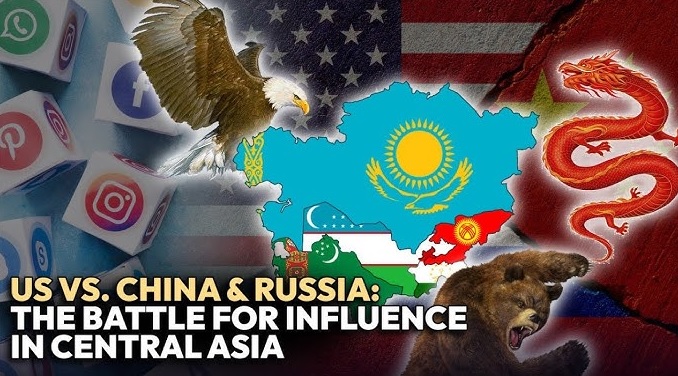
Central Asia has become a new front of rivalry between the U.S. and China, with an emphasis on economic dominance, notes ‘Daily Sabah’ from Türkiye.
As the 2024 U.S. presidential election nears, international attention is fixated on domestic issues, the U.S. stance on Ukraine, and its mishandling of the genocide in Gaza. Yet, beneath the surface, a strategic shift in U.S. foreign policy is quietly taking shape.
Central Asia, often overshadowed in broader geopolitical discussions, may be the key to understanding this strategic realignment. While maritime areas have dominated discussions about U.S.-China rivalry – most notably the tensions in the South China Sea – China’s historical foreign policy tradition is grounded in territorial influence. Unlike its maritime ambitions, China’s focus is increasingly on Central Asia, a region of immense strategic importance.
At first glance, the U.S. strategy to counter Chinese expansion seems concentrated on maritime disputes, particularly in the South China Sea, where tensions have been a recurring theme for over 15 years. While focusing on maritime routes is understandable, it's essential to recognize that China's historical foreign policy is rooted in land-based territorial influence rather than maritime power.
In this context, Central Asia emerges as a critical focal point for China. Following the global economic downturn in 2008 and the eurozone debt crisis in 2010, China seized the opportunity to enhance its role on the world stage. The Belt and Road Initiative (BRI), launched in 2013, exemplifies this strategy. This ambitious infrastructure and investment project aims to boost trade and connectivity across Eurasia, with Central Asia serving as a key transit region.
From 2013 to 2023, China invested over $40 billion in Central Asia to improve infrastructure and strengthen regional ties. During this period, bilateral trade between China and Central Asian countries increased significantly, rising by over 50% from $30 billion in 2013 to $50 billion in 2022. China's investments are notably concentrated in energy resources, reflecting its strategic interests. In Kazakhstan, China invested more than $20 billion, with the major project being the China-Kazakhstan oil pipeline. In Uzbekistan, Chinese investments exceeded $10 billion, focusing on modernizing oil and gas infrastructure. In Turkmenistan, China invested around $8 billion, primarily in the Central Asia-China gas pipeline, which is vital for transporting natural gas from Turkmenistan to China. China is now the largest buyer of Turkmen gas, receiving billions of cubic meters annually. China's economic growth heavily relies on energy imports, with oil and gas constituting 29% of its energy mix. Central Asia plays a crucial role, accounting for nearly 30% of China's oil and gas imports. Given the ongoing geopolitical tensions in Ukraine and the Middle East, China’s dependence on Central Asia for energy security is increasing.
Additionally, China must secure its western borders in the event of American containment and maritime pressure. As demonstrated by recent developments in early March 2024, the U.S. is prepared to use all available tools to constrain China's growing influence in the East and South China Seas. In this context, Central Asia becomes crucial for China, serving as its primary overland gateway to global markets via railways and roads. Consequently, revitalizing the "Silk Road" is essential for China’s strategic access and economic expansion.
Following the fall of the Soviet Union, the U.S. aimed to influence Central Asia to shape the world according to its vision. However, this strategy faced setbacks. The 9/11 attacks led to heightened security concerns, labeling Central Asia as a key region for counterterrorism, particularly in the Ferghana Valley. Initially, the U.S. extended support to these relatively fragile states, establishing military bases in Kyrgyzstan, Uzbekistan and Tajikistan to fill the vacuum left by the Soviet collapse and to counterbalance Russia and China.
The final withdrawal of U.S. forces from Afghanistan on Aug. 30, 2021, marked a shift toward a revised containment policy. In September 2023, for the first time, U.S. President Joe Biden met with leaders of all five Central Asian republics in a C5+1 summit. Following this, the Biden Administration committed an additional $25 million to expand the Economic Resilience Initiative in Central Asia (ERICEN), aiming to boost private-sector investment.
This shift in strategy is significant. In October 2022, Russian President Vladimir Putin held a similar C5+1 meeting with the region's leaders, and in May 2023, Chinese President Xi Jinping hosted a similar summit.
The U.S. strategy can be seen through the lens of B. H. Liddell Hart’s insight into using decoys effectively: “The most effective way to use a decoy is to make the enemy believe that the decoy is the main objective, thereby diverting their attention and resources away from your true goal.” In this context, the U.S. has subtly shifted its focus from overt maritime competition to a more comprehensive approach that includes Central Asia’s geopolitical significance.
For too long, both officials and scholars have emphasized the importance of maritime strategies to counter China's growing influence. However, the Western approach extends beyond Alfred Mahan's "naval supremacy" thesis; it also incorporates Halford Mackinder's concept of "terrestrial supremacy." Given China’s historical emphasis on land-based influence, Central Asia emerges as a crucial battleground. In this geopolitical game, the U.S. strategy encourages China to focus its resources on maritime endeavors, potentially weakening its influence in Central Asia.
As the great game of geopolitics unfolds, Central Asia’s role becomes increasingly central, making it a critical focus for both U.S. and global strategies.
read more in our Telegram-channel https://t.me/The_International_Affairs

 10:41 05.10.2024 •
10:41 05.10.2024 •






















